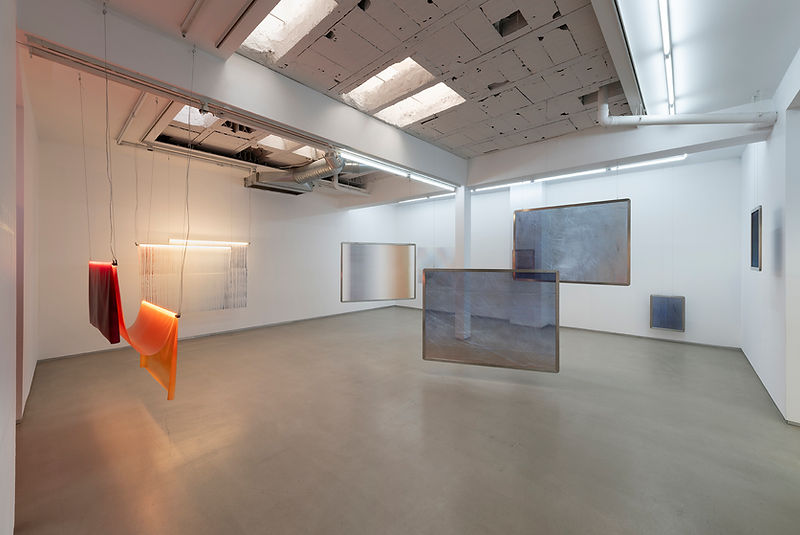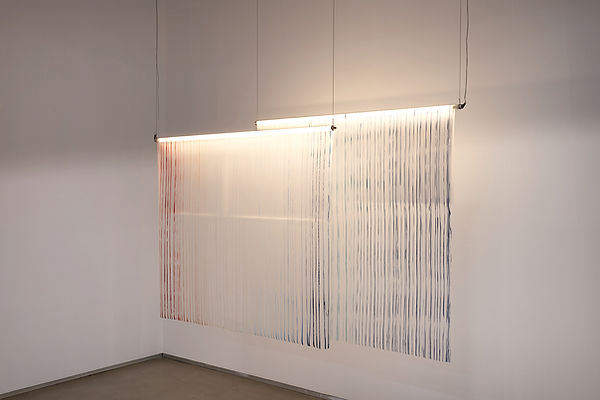
MY SHADOW IS YOURS
In dialogue with Luísa Jacinto
FVTVRIST Magazine // October 27, 2025
Through translucent surfaces and suspended membranes, Luísa Jacinto builds delicate worlds that unfold slowly, inviting the viewer to pause and look again. In My shadow is yours at Parra & Romero, Madrid, the artist continues to explore the central themes of her practice: perception, memory, and time, how images breathe, fade, and return. The title, borrowed from Malcolm Lowry, captures the essence of her work: a space of reciprocity where the gaze and the image lean toward one another, revealing what hides within the act of seeing. She makes us reconsider how to see through layers. In conversation with FVTVRIST, Luísa Jacinto reflects on transparency, literature, and the shadow as a tender metaphor for being.
Exhibitions
Now on view: My shadow is yours, Madrid, September 10 – November 01 , 2025
Coming Soon: Things change quickly, Chicago, November 07 – December 20 , 2025

Portrait of Luísa Jancito. Photo credit: Paola Caballero
Your recent exhibition My shadow is yours in Madrid takes its title from Malcolm Lowry’s Under the Volcano. It evokes a relationship of dependency and reciprocity, almost a dialogue between viewer and work. What drew you to this title, and how did Lowry’s words resonate with the ideas you wanted to explore?
I read the book Under the Volcano many years ago, and I still remember its wondrous atmosphere. I came across this quote again recently, and found it very beautiful, this mix of vulnerability, openness, shelter, giving. When working, I often come back to very simple questions: What is it to see? How do we see? If it wasn’t for shadows, for matter absorbing some light and reflecting another, we wouldn’t see at all, it would be either all white (pure light) or all black (either no light or all light absorbed). So with this in mind I was thinking that all our visual experience is based on a subtractive attribute. On the other hand, there is this suggestion of complementarity and interdependency that is very dear to me, as I find it everywhere in life.
Your work often lives in the space between opposites: visibility and concealment, intimacy and distance, solidity and light. In My shadow is yours, the shadow becomes both a metaphor for the human condition and a space of care and fragility. What does the shadow represent for you today conceptually?
Yes, I agree, I guess more and more my work deals with this interplay of presence and absence. I’ve always painted through shadows. It’s a funny conclusion, but that is really the case, even in earlier figurative works, it’s all made through shadow placing, it’s all about the shadow! The shadow is a summarized translation of a body through light, time and space. It reveals a lot. I’m also fond of the Jungian reading of the shadow: as the repository of our unknown and unconscious elements. It contains not only what we reject about ourselves but also our greatest untapped potential – accessible through ritual, representation and play. Working in the contemplative, representational, play-role field of visual arts is a never-ending inquiry in a very large playground to this matter.

Installation view, My shadow is yours, Luísa Jacinto, Parra & Romero, Madrid, 2025. Photo credit: Roberto Ruiz
What guides your choice of materials (acrylics, polyester, veils) and how do these substances contribute to the kind of atmosphere you want to create?
I have been after translucent and transparent elements in the painterly realm for some time now. Seeing through, and sensing that other things come through us just as well. The desire to know things, to really know them, from the inside out!
In several of your exhibitions (Véu-Pedra, Solombra, Shining Indifference) you explore transparency, layering, and reflection. How are these ideas connected for you?
I have been working with translucent fabrics, painting them on both sides so there is no front and back. I was after a transparency without the weave and weft of the fabric structure, as somehow the nature of these paintings and spatial gestures had nothing to do with an orthogonal configuration. Fortunately, I came across this new material, synthetic rubber, that comes from the liquid state and allows me to build the support and paint simultaneously, so one ends up with one indistinguishable body.
In the exhibition My shadow is yours, for instance, I’m showing three different types of works: the rubber membranes suspended in LED tubes, that work as large luminous colour stains hanging in space, some works from the series “Work in space” that are made of an extremely large weave and weft of a nuance of colour that hold firm in space, and the works from the series “I was never” and “Not knowing”, constituted of paintings on a translucent fabric stretched on stainless steel frames.
The choice of materials and installation decisions come from an intuitive sensitivity, and I take time, make models, play around, until I find a strong hold around everything. The decisions are really what makes the work as it is. Lighting is also decisive.
How can we change the perception of a given space with relatively simple means? Estrangement as a step to clarity. “The more of a no-one I become, the better I will be able to see.”


Not knowing III, 2025, Spray paint and acrylic on polyester, stainless steel, 70 x 55 cm. Photo credt: Roberto Ruiz
I was never V, 2025, Spray paint and acrylic on polyester, stainless steel, 130 × 185 cm
Photo credt: Roberto Ruiz
Many of your exhibition titles have a literary tone ( La mañana no será diferente de la noche, A ideia de voltar, My shadow is yours). Are you often inspired by literature? Do the titles come before or after the works?
It´s funny you ask this. I think of painting and reading as very close activities, almost as two sides of the same coin. Reading a painterly surface, reading an environment, reading – digestive, hermeneutical, open to interpretation. Inter-dependency, complementarity. Time. The viewer’s trajectory as an editing process, or as the fulfilment of the work really.
I am hugely influenced by literature. Reading is a survival territory, and I would not be the person I am had I not read what I have. And there is still so much ahead!
The titles usually come after the works, or close to their conclusion. Sometimes the title finds me, other times it does not surface so easily, and I look for it. Real life, literature and poetry are the main sources.
What are you reading now? Do certain books, writers (or perhaps music) accompany you during the making of a series of artworks?
I am currently reading “Joseph and his brothers” by Thomas Mann. I’m also revisiting the poems of Adélia Prado, an author I constantly come back to, and recently I’ve read Natalia Ginzburg’s “All our yesterdays” and found it a treasure.
Finally, if the shadow is a metaphor for the human condition, as your title suggests, what do you think it reveals about us today?
The shadow might be similar to “the zone” in Stalker, Tarkovsky’s master-piece. Maybe it will reveal us our deepest desire, if only we are willing to face it.
Walking through the exhibition, we noticed that time seems essential to how your work is experienced. The viewer must slow down, adjust, wait for the image to reveal itself, observe from different angles. Is this “slowness” something you deliberately construct in your process?
Yes! The more I work, the more I suspect time is the main subject of my practice. Our perception in time, our perception of time itself. Time is flexible, time is a pouring gift. It’s interesting to know that Brunneleschi was playing with mechanical clock mechanisms at the same time as he systematized the linear perspective, by the early XVth century. This is usually said to be the beginning of the Renaissance, that drastically changes the western perception of time, but it did nothing to time, the matter, itself. Slowing down in the times we are living in is a prerequisite for nurturing an inner life!

Photo credt: Roberto Ruiz
Installation view of the series I was never, 2022-25 and Not knowing, 2025
Photo credt: Roberto Ruiz



FOR THIS EXHIBITION, I IMAGINED PARRA & ROMERO’S ROOMS, AND THE WORKS BETWEEN EACH OTHER, WHISPERING ... MY SHADOW IS YOURS… I’LL SHOW YOU… NO ONE CAN STEAL A SHADOW. I LIKE TO THINK OF INSTALLATION AND PAINTING AS A WAY OF BECOMING PROGRESSIVELY AWARE OF BEING IMMERSED IN ANOTHER ELEMENT ENTIRELY.
In November, you’re preparing your upcoming exhibition at Document Space Gallery in Chicago, titled Things change quickly. What changes? What does this new exhibition represent for you at this moment in your trajectory?
I’m very excited with that exhibition coming up! Perception, light, time changes. Everything changes. Things change quickly. The exhibition will be constituted of a large coloured cloud (made of eight membranes), and some spider webs on the corners (made of my ossified grids). The light in the room will emanate primarily from the membrane works, colouring the whole exhibition space by contamination, and we’ll also spotlight the nets in such a way as to use the shadow as an element of the work itself. This is my plan, but of course things might present themselves differently in real life, and we’ll work with what presents itself there so we bring the best exhibition possible to presentation. This is going to be my first solo exhibition in the United States, and I really admire Document Space’s programme and choices, so it’s all very encouraging and I’m looking forward to it!


FIN
About Luísa Jancito
Luísa Jacinto lives and works in Lisbon. Her practice unfolds within the expanded field of painting and image-based installation, researching how perception, memory, and representation construct the visible. Exploring the tension between revelation and concealment, her works invite reflection on what resists visibility, spaces where meaning slips between image and absence. Through painting, photography, and spatial installation, Luísa Jacinto articulates a quiet phenomenology of seeing. Her work has been shown at the MAAT Museum, Museu Coleção Berardo, Museu Carlos Machado, Fosun Foundation (Shanghai), Galeria Quadrado Azul, and galería silvestre (Madrid), among others.